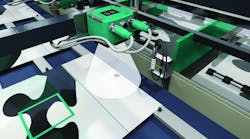Bar codes, those ubiquitous visual patterns that communicate data to machines, have proliferated. Traditional 1D bar codes (with printed bars and spaces) are giving way to 2D bar codes that also include dots, hexagons, and even colors to encode more data.
Bar-code scanners read 1D bar codes. Some emit lens-focused laser beams that are reflected off the bar code and back to a photodetector that converts the analog signal into digital data for processing to extract encoded information. Other bar-code scanners use a complementary-metal–oxide semiconductor (CMOS) or charge-coupled device (CCD) to detect a bar code’s pattern using ambient or device-effused light.
In contrast, bar-code imagers (also known as digital or area imagers) read both 1D and 2D bar codes using CMOS or CCD sensors. However, unlike those in scanners, the sensors in imagers include many rows of sensor cells to read 2D bar codes.
When a bar code comes into the imager’s field of view, a (typically photoelectric) trigger signals the imager that a code is in the camera’s range. Once the code is visible to the camera, a picture is taken with a CMOS or CCD imager. Software attempts to identify the bar code’s orientation within the captured camera image. Dark bar codes on light or plain backgrounds are quickly processed; bar-code captures that crop out the background also do well. The image must be decoded in a predetermined amount of time, or the imager gives a read failure.
Some CMOS camera types have 752 × 480-pixel arrays. Each pixel registers one of 256 grayscale values, and the sum result is a grayscale image used by a processor to extract encoded data.
Of the roughly 50 2D bar-code types, QR is one of the most common. This ISO-standardized code pattern incorporates squares on three corners to help camera software identify and orientate images. A series of alternating white and dark squares connect the corners to further aid cameras in locating all columns and rows. A small square in the lower-right corner is used to adjust the camera image for skew and accommodate a misaligned camera angle. In the future, as QR codes get physically bigger to contain more data, more alignment squares will be located at regular intervals throughout the image.
Pepperl+Fuchs provided information for this column.

